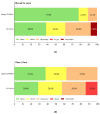Comparison of Clinical Outcomes, Visual Quality and Visual Function of Two Presbyopia-Correcting Intraocular Lenses Made from the Same Material, but with Different Design and Optics
- PMID: 34362052
- PMCID: PMC8347739
- DOI: 10.3390/jcm10153268
Comparison of Clinical Outcomes, Visual Quality and Visual Function of Two Presbyopia-Correcting Intraocular Lenses Made from the Same Material, but with Different Design and Optics
Abstract
This semi-prospective, parallel, comparative investigation evaluated the clinical outcomes and quality of vision (contrast sensitivity, visual function, dysphotopsia, spectacle use, overall satisfaction) after mono- or bilateral implantation of two presbyopia-correcting intraocular lenses (IOL)-the Liberty® 677MY or the AT LISA® tri 839M-in 50 eyes of 25 cataract patients. Clinical outcomes were assessed 3 and 12 months postoperatively. Eighty-nine percent of eyes implanted with the Liberty IOL and 59% of eyes implanted with the AT LISA IOL achieved a refractive outcome ±0.5 diopters of the target (emmetropia). Refractive outcomes were stable with both lenses. The proportions of eyes with 20/20 uncorrected distance visual acuity (UDVA) and 20/20 uncorrected near visual acuity (UNVA) were higher in the Liberty group than in the AT LISA group (UDVA: 56% vs. 41%; UNVA: 83% vs. 66%). Optical quality assessment results were comparable for the two IOLs. Superior photopic contrast sensitivity was found with the Liberty lens. The rate of Nd:YAG capsulotomy at the 12-month follow-up was 16.7% in the Liberty group and 40.6% for the AT LISA IOL. Considering that both lenses are made from the same material, we propose that the noted differences in clinical outcomes may derive from differences in design and optical surface between the two IOLs.
Keywords: 677MY; 839M; cataract; contrast sensitivity; dysphotopsia; multifocal intraocular lenses (MIOL); posterior capsule opacification; presbyopia; visual function; visual outcomes.
Conflict of interest statement
The authors declare no conflict of interest.
Figures







References
-
- ESCRS 2019 Clinical Trends Survey Results. [(accessed on 5 November 2020)];EuroTimes. 2020 Available online: https://www.eurotimes.org/wp-content/uploads/2020/11/Clinical-Survey-Res....
LinkOut - more resources
Full Text Sources

